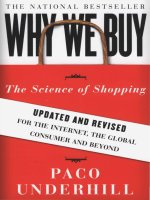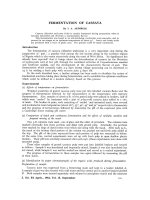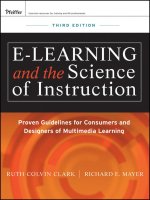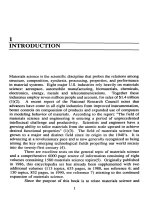Why We Buy: The Science of Shopping--Updated and Revised for the Internet, the Global Consumer, and Beyond
Bạn đang xem bản rút gọn của tài liệu. Xem và tải ngay bản đầy đủ của tài liệu tại đây (11.08 MB, 309 trang )
THE
NATIONAL
BESTSELLER
"At
last, here is a book that gives this unde
rrat
ed skill the respect it d
ese
rv
es."
-
Th
e
New
York
Times
"Thanks,
Mr
. U
nd
er
hill, for
explaining in clear and
witt
y prose
why
my
shopping habits are not
all
th
at crazy. Now,
pl
ease
tell my wife!"
-
Bob
Gale.
\\ rilerlprodu('er,
Ba
ck
to
the
FUlu
re
tril
ogy
"
I'm
in l
ove
. And
if
I didn't have a devoted
hu
sba
nd
,
two
kid
s
and
a c
ru
shing
mortga
ge, J sw
ea
r I'd
throw
ca
ution
to
the wind and run a
wa
y with
Paco U
nd
erhill .
f
asc
inating."
-
Ro
cky Mounlain News (De
nv
er)
"Why We
Bu
y
is
a
funny a
nd
insightful
b
oo
k
for
people
on
both s
id
es of the
retail counter."
-
Micha
el
Gould. CEO,
Bl
oo
mingdale's
Praise For
Paco Underhill
and
Why
We
Buy
"The Dalai Lama said, 'Shopping
is
the museum
of
the twentieth cen-
tury.' Paco Underhill explains
why.
Brilliantly."
-Faith
Popcorn, author and Future Forecaster
"Why
We
Buy
is
useful
as
a.
how-to. for retailers,
but
shoppers will
dis-
cover a
Vance
Packard for our times, on the trail
of
our
century's hidden
persuaders."
-Hardy
Green,
Business
Week
"For retailers, this book should be mandatory.
For the rest
of
us, it's
just plain
fun."
-Harvey
Schachter,
The
Globe.
and
(Toronto)
"No matter which point
of
view you're coming from, shopper
or
shop-
keeper, you'll find Underhill's tips are often funny, sometimes provoca-
tive,
and almost always usable."
-The
San
Diego
Union-Tribune
"What Underhill offers in this delightful and engrossing book
is
a primer
in the science
of
shopping
The effect
of
reading this book
is
that
of
being alternately entertained by hilarious stories and enlightened by
trenchant
observations."
-Newsday
"Underhill's way
of
looking at how we shop may revolutionize the in-
dustry.
In this day
of
heavy competition, advice from this
book
could
give a retailer the edge needed to survive
This
book
prOvides an
excellent method for retailers to examine their own store space and look
for what
may
draw customers in,
as
well
as
what may be causing them
to leave without
buying."
-Teresa
McUsic,
Star-Telegram
(Fort Worth)
"The guru
of
retail consulting offers a wealth
of
inSight into what makes
a successful shopping experience for both buyer and
seller."
-Craig
Ryan,
The
Oregonian
'1\ fascinating voyage through the mall that will open your
eyes
to the
psychology
of
modern
retailing-and
especially to the new dynamics
of
consumer shopping."
-G.
William
Gray,
The
Tampa
Tribune
"Ostensibly a business
book
aimed at merchandisers, Why
We
Buy
will
also appeal to consumers who want to understand the art
of
shopping
and the science
of
selling."
-Justin
Adams,
MSNBC
"Paco Underhill
is
Sherlock Holmes for retailers
This sleuth makes
shoppers view stores with more critical
eyes."
- Trish Donnally,
San
Francisco
Chronicle
'1\ remarkable business tool, a distillation
of
all
those notes and tapes;
packaged in a way that
is
useful, witty, and loving."
-Keith
H. HaI?monds,
Fast
Company
'1\ readable, entertaining study
of
the behavioral science
of
shopping."
-Adrienne
Miller,
Esquire
"Intriguing for both lovers and haters
of
the game
of
visual stimula-
tion."
-Booklist
"This lighthearted look at shopping
is
highly recommended to anyone
who buys
or
sells."
-Rob
McDonald, Amazon.com
WhyWeBuy
TH
E
SCI
ENCE
OF
SHOPPI
N'G
Updated
and
Revised
for
the Internet,
the Global
Consumer
and
Beyond
Paco
Underhill
ACKS
I
Simon & Schuster Paperbacks
A Division
of
Simon & Schuster, Inc.
1230
Avenue
of
the Americas
New
York,
NY
10920
Copyright © 1999, 2000,
2009
by Obat, Inc.
All
rights reserved, including the right to reproduce this
book
or
portions
thereof
in any
form
whatsoever. For information, address
Simon & Schuster Paperbacks Subsidiary Rights Department,
1230
Avenue
of
the
Americas, New
York,
NY
10020.
This Simon & Schuster trade paperback edition January 2009
SIMON
& SCHUSTER
PAPERBACKS
and colophon are
registered trademarks
of
Simon & Schuster, Inc.
For information
about
special discounts for bulk purchases,
please contact
Simon & Schuster Special Sales
at
1-800-456-6798
or
Manufactured
in
the United States
of
America
10
9 8 7 6 5 4 3 2
The
Library
of
Congress has cataloged the hardcover as follows:
Underhill, Paco.
Why
we
buy: the science
of
shopping / Paco Underhill.
p.
cm.
Includes index.
1.
Marketing research.
2.
Consumer behavior.
3.
Shopping. I Title.
HF5415.2.U53
1999
658.8'34-dc21
99-12125
CIP
ISBN:
0-684-84913-5
ISBN-13: 978-1-4165-9524-3
ISBN-IO:
1-4165-9524-4
DEDICATION
Who knew when the first keystrokes
of
this document were made in
the spring
of
1997 that ten years and twenty-seven foreign translations
later this book would still be
alive?
I am grateful that in the summer
of
1999, when this book came out, my father, Francis Underhill, got to see
it. I don't think he really knew what I did even after reading it.
He
had
a lot
of
interests, but shopping wasn't ever among them. He died that
fall.
I was there. I made him a martini and
helpe~
him get comfortable
in bed. He went, sleeping next to my mother, his wife
of
more than
fifty
years. I still talk to him.
AUTHOR'S
NOTE
For some
of
you, the book you hold in 'your hands may be an old
friend-given
as
a gift, bought in an airport, secured through Amazon
or assigned at a school or training progam. Thanks for picking it up
again. Most volumes stocked in the business section
of
a bookstore have
a short shelf
lif~.
They zoom and crash and are forgotten within a year.
This book has lasted ten years and
is
available in twenty-seven foreign
editions. I had no idea when pen first went
to
paper back in 1997 that
my story would appeal to so many readers.
From Russia
to
Japan, from Spain to Thailand, I've had visits and
e-mails from readers just wanting. to say hi, many looking for a job
and not a
few
telling me their own stories. University professors from
China, a Marxist minister in
t;he
Bengali provincial government, a jew-
elry deSigner from
Spain-the
list goes on.
My
favorite pieces
of
corre-
spondence came from a man who ran a septic tank cleaning business in
Missouri. The letter was handwritten
on
lined paper. I don't know
how
many letters that man writes a year,
but
I know I was privileged to get
one
of
them. He'd read the book and wanted my advice
on
what color
to paint his truck.
In 2007, I reread Why
We
Buy
and realized that parts
of
the story
had progressed and that some
of
the example's I'd tised were dated.
The book needed freshening and that's what it's gotten. If you liked it
the first time, you'll like it even better the second. If you're picking it
up for the first time, whether you love
or
hate shopping, this
is
a good,
entertaining read, and you'll never look at the world
of
shopping and
consumption the same way again.
Paco
Underhill
January
2009
CONTENTS
I
INSTEAD
OF
SAMOA,
STORES:
THE
SCIENCE
OF
SHOPPING
1. A Science
is
Born 3
2.
What Retailers and Marketers Don't Know
28
II
WALK
LIKE
AN
EGYPTIAN:
THE
MECHANICS
OF
SHOPPING
3.
The Twilight Zone
4.
You
Need Hands
5.
How to Read a Sign
6.
Shoppers
Move
Like People
7.
Dynamic
III
MEN
ARE
FROM
HOME
DEPOT,
WOMEN
ARE
FROM
BLOOMINGDALE'S:
THE
DEMOGRAPHICS
OF
SHOPPING
8.
Shop
Like
a Man
9.
What Women Want
42
50
61
77
89
102
121
xii
CONTENTS
10.
If
You
Can Read This You're Too Young
137
11.
KJds
151
IV
SEE
ME,
FEEl
ME,
TOUCH
ME,
BUY
ME:
THE
DYNAMICS
OF
SHOPPING
12.
The
Sensual
ShQI>per
171
13.
The
Big
Three
194
14.
Time
201
15.
Cash/Wrap
Blues
208
16.
Magic Acts
213
V
SCREEN
SAVERS,
JET
LAG
AND
WHIRLING
DERVISHES:
THE
CULTURE
OF
SHOPPING.
17.
The
Internet 227
18.
Come
Fly with Me 254
19.
Windows
of
the World
268
20. Final Thoughts
(
280
Acknowledgments
293
Index
299
I
Instead
of
Samoa,
Stores:
The
Science
of Shopping
ONE
A
Science
Is
Born
o
kay,
stroll, scroll, stroll. , .
.<tot>
Shhh. Stay behind that potted palm. Get out your clipboard and
pen.
Our subject
is
the fortyish woman in the tan trench coat and blue
skirt. She's in the
b~th
section. She's touching towels. Mark this
down~
she's petting one, two, three, four
of
them so
far.
She just checked the
price tag on one. Mark that down, too.
Careful-don't
get too
close-
you don't want her to see you. She picked up two towels from the table-
top display and
is
leaving the section with them. Mark the time.
Now,
tail her into the aisle and on to her next stop.
Thus begins another day in the vineyards
of
science, specifically the
science
of
shopping. But let's start by addressing a fundamental ques-
tion:
Since
when does such a scholarly discipline even
exist?
Well,
if,
say,
anthropology had devoted a branch
of
itself to the
study
of
shoppers in situ
(a
fancy Latin way
of
saying shoppers
out
shopping), interacting with retail environments (stores, but also banks
,
and
restaurants), the actual, physical premises, including
but
not
limited
3
4
WHY
WE
BUY
to every rack, shelf, counter and table display
of
merchandise, every
sign, banner, brochure, directional aid and computerized interactive
informational fixture, the entrances and
exits,
the windows and walls,
the elevators and. escalators and stairs and ramps, the cashier lines and
teller lines and counter lines and restroom lines, and every inch
of
every
aisle-in
short,· every nook and cranny from the farthest reach
of
the
parking lot to the deepest penetration
of
the store itself, ifanthropology
had already been studying all that
and
not
simply studying the store,
of
course, but what, exacdy and precisely-scientifically-human beings
do in it, where they go and don't go, and by what path they go there;
what they see and
fail
to see, or read and decline to read; and how they
deal with the objects they come upon, how they
shop,
you might
say-
the precise anatomical mechanics and behavioral psychology
of
how
they pull a sweater from a rack to examine it, or read a box
of
heartburn
pills or a fast-food restaurant menu,
or
grab a shopping basket, or react
to the sight
of
a line at the ATMs
again,
as
I
say.
ifanthropology had
been paying attention, and not just paying attention
but
then collect-
ing, collating, digesting, tabulating and cross-referenCing every litde bit
of
data, from the extremely broad (How many people enter this store
on
a typical Saturday morning, broken down by age,
sex
and size
of
shopper group?) to the extremely narrow (Do more male supermarket
shoppers under thirty-five who read the nutritional information on the
side panel
of
a cereal box actually buy the cereal compared to those who
just look at the picture on the front?), well, then, we wouldn't have had
to invent the science
of
shopping. In
1997,
when this volume was origi-
nally written, the academic world knew more about the marketplace
in Papua New Guinea than what happened at your local supermarket
or
shopping mall. Twentieth-century anthropology wasn't about what
happened in your backyard.
I~1997,
I'd been fighting for what I knew was right for more than
ten
years-and
since then, a whole lot has changed. Companies across .
the world are now employing anthropologists to staff what have been
popularly tided shopper and consumer insight groups. Ethnologic stud-
ies (that
is
to
say.
a science that breaks down humans into races, cultures
and their various obvious and not-so-obvious characteristics) are part
A
Science
Is
Born
5
of
mainstream market research. But when I first hung
out
my
shingle,
my· academic colleagues thought I was selling out, and the marketers
and merchants I sought to serve looked
at
me
as
an alien from a distant
planet.
Down the hall from my office then and
now
is
an equipment
room
with more than one hundred cameras. Eight-millimeter video cameras,
direct to hard drive, digital, even a few ancient
Super 8 time-lapse film
cameras. To keep track
of
them, every camera
is
assigned a
name-the
video cameras are named after rock stars, the digital stills are signs
of
the zodiac. We find giving a camera a name rather than a number helps
it last longer, and when Jimi Hendrix feels poorly,
he
gets
to
the shop
faster than
if
he were camera number 26. In that same equipment
room
are piled cases
of
blank eight-millimeter videotapes, two hours
per
tape,
five
hundred tapes to a case. Across the world,
we
have
now
shot
more than fifty thousand hours
of
tape per
y~ar.
We also have dozens
of
handheld computers,
or
PDAs,
on
which we painstakingly
jot
down the
answers from the thousands
of
shopper interviews we conduct; there
are laptops in there, too, plus all manner
of
tripods, mounts, lenses and
other camera accessories, including lots
of
duct tape. Oh, and many
well-worn hard-shell cases for everything, because it all. travels. A lot.
The studio next to the equipment room has two complete digital edit-
ing suites and eleven stations at which
to
watch all those
tapes-because
everything we shoot, we look at. We have more than enough gear in
that room to make broadcast-quality documentaries and, while we're
at it, to equip a good-sized university's school
of
social anthropology
or
experimental psychology, assuming the university has a deserved reputa-
tion for generating tons
of
original research gathered from all over the
globe.
Even with all that high-tech equipment, though,
our
most important
. research tool for the past thirty years remains the piece
of
paper we call
the track sheet, in the hands
of
the individuals we call trackers. Track-
ers are the field researchers
of
the science
of
shopping, the scholars
of
shopping, or, more precisely,
of
shoppers.
Essentially, trackers stealthily
make their way through stores following shoppers and noting every-
thing ·they do.
Usually a tracker begins by loitering inconspicuously near
6
WHY
WE
BUY
a store's
e~trance,
waiting for a shopper to enter, at which point the
"track" starts. The tracker
will
stick with the unsuspecting individual
(or individuals)
as
long
as
he
or
she
is
in the store (excluding trips to
~e
dressing room
or
the restroom) and
will
record
on
the track sheet virtu-
ally everything the shopper does.
Befitting a science
that has grown up in the real world, meaning far
from the ivory towers
of
academia,
our
trackers are
not
stamped from
the usual researcher mold. In the beginning we hired graduate environ-
mental psychology students,
but
we found they were often unsuited to
the
work-more
often than not, they came to the job burdened with
newly learned textbook theories they wished to prove
or
disprove.
As
a result, they didn't possess the patience necessary to watch many
shoppers at great length to see what they actually do. Creative people,
however-playwrights, artists, actors, novelists, a
puppeteer-have
proven to be perfect for this work. They have no theories to uphold
or
demolish, just open minds and boundless curiosity about what people
do and how and why they do
it;
They are dispassionate yet avid observ-
ers with
no
agenda except for wanting to accurately document how
human behavior plays
out
in the retail arena. They manage to see the
forest, the trees and everything in between.
When
we find someone with the temperament and the intelligence
for this work, we first
put
them through a training session in our office.
There's a lot to
learn-how
do I watch and simultaneously
take
notes,
for instance,
or
how can I tell whether someone
is
reading a sign
or
just
staring at the mirror next to
it?
We have to teach the most important
tracker skill
of
all:
How do I stand close enough to study someone
without being
qoticed?
B~cause
it's crucial to our work that shoppers
don't realize they're being observed. There's no other way to be sure
that we're seeing natural behavior. Fact is,' we're
al(
still surprised by
how close you can stand
to
someone in a store and still remain invisible
We find that positioning yourJelf behind the shopper
is
a bad
idea-we
all
pick up
on
the sensation that we're being watched. But if you stand
to the side
of
a shopper, his
or
her peripheral vision reads you
as
just
another customer-harmless, in other words,
an~
barely worth notic-
ing. From that position you can get close enough to see exactly what
A Science
Is
Born 7
a shopper
is
doing.
You
can be sure that he's touched,
say,
nine golf
gloves, not eight
or
ten.
Then
we throw the tracker-hopefuls
out
into
the real world, into a store setting, to see them in
actioI?-'
Most
of
them
wash out at this
point-you
can teach technique,
but
not the smarts
or
the slight case
of
fascination required to do this work well. It's weirdly
addictive, and many
of
our
trackers have been with us for a decade
or
more.
John has been doing fieldwork for my company, Envirosell, for more
than ten years, in between workirtg
as
a kindergarten teacher. Trained
to monitor five-year-olds, does he have patience?
Oh, yeah.
He
also
just
c9mpleted his two-hundredth fieldwork assignment. He's
of
medium
height, with brown hair, a spare build, crinkles
in-the corners
of
his eyes
and big broad feet.
He
has
no
trouble standing all
day.
In
our
tracker
pool, we also have rookies who are still getting twenty trips under their
belts, intermediate-level
trackers~
master trackers, team leaders . . .
and Noah, who, after thirteen years
of
tracking and team leading, now
directs the forty-plus members
of
our
tracking staff based
out
of
our
home office in New
York
City.
We found Noah in Nashville.
He
was a
last-minute replacement, a struggling music student who three hours
into the job had found his calling. The first time he walked into my
of-
fice
he was dripping with nervous sweat (he'd never been to New
York
before). Thirteen years later, I still can't break him
of
the habit
of
calling
me
Mr.
Paco.
In addition to measuring and counting every significant motion
of
a single shopping trip,
our
trackers also have to contribute incisive field
notes describing the nuances
of
customer behavior and make good
-inferences based on what they've observed. These notes add up to yet
another, this time anecdotal, layer
of
information about a particular
environment and how people use it.
Our
trackers crisscross this conti-
nent,
as
well
as
the globe. As
of
2008, we have offices in Mexico
City,
Sao
Paulo, Milan, Bangalore, Moscow and Tokyo, and each office has its
own tracker pool.
All
across the world, Envirosell trackers spend more
time in stores in a month than most people do in several years. They
visit
every kind
of
retail business
imagin~ble,
from banks to fast-food
restaurants to high-end fashion boutiques to hangar-sized discounters.
8
WHY
WE
BUY
Since 1997, we've worked hard to expand
our
repertoire
of
field sites,
adding concert halls,
stadiu~s,
train stations and airports
as
well
as
li-
braries, museums, hotels and websites (more about those later). But our
sweet spot remains what we've always done.
Of
the world's fifty largest
merchants, we've worked with approximately half, and in the
U.S.
alone,
our
clients include more than a third
of
Fortune magazine's top one huri-
dred corporations.
As
for the forms
our
trackers
use?
They're also marvels
of
data gath-
ering. They have evolved constantly over the three decades we've been
doing this
research and are, without a doubt, the key to the entire
en-
terprise, a great achievement,
if
I may say so,
in
the art
of
information
storage and retrieval, nondigital division.
We
have tried scanning
sys-
tems, exotic software packages
and we keep going back to the same
old system. It works, it's flexible, and thanks
to
Wite-Out and a copy
machine, it can be changed
on
a dime and on the
fly.
Our
ability to react
to what and
whom
we find walking through the door
of
wherever loca-
tion we go
is
critical to
our
success.
1'd
guess that at least one third
of
the time we go on location, we end up finding something very different
than what
our
client told us we'd
find.
The store has
six
aisles and not
seven, the shelf layout has
been
mysteriously reversed
or
that interactive
machine we were hired to study arrived at the store nearly a month ago
and hasn't worked since.
Our
earliest track sheets were able. to record maybe ten different
variables
of
shopper behavior.
Today.
we're up to around
forty.
The
form
is
reinvented for every research project we undertake,
but
typi-
cally it starts with a detailed map depicting the premises we're about
to study, whether it's a store, a bank
br~nch,
a parking lot (for a
drive-
_
~ru
project)
or
just a single
section-even
just one
aisle-of
a store.
The map shows every doorway and aisle, every
display,
every shelf and
rack and table and counter. Also
on
the form
is
space for information
about the shopper
(sex,
race, estimate
of
age,
deSCription
of
attire) and
what he
or
she does in the store. Using the system
of
shorthand nota-
tion we've developed over the years, a
cO':Ilbination
of
symbols, letters
and hash marks, a tracker can record, for instance, that a bald, bearded
man in a red sweater and blue jeans entered a department store on a
A Science
Is
Born 9
Saturday at
11:07
A.M.,
walked directly to a first-floor display
of
wallets, .
picked up or otherwise touched a total
of
twelve
of
them, checked the
price tag
on
four, then chose one, and moved at 11:
16
to a nearby tie rack,
stroked seven ties, read the contents tags on all seven, read the price
on two, then bought none and went directly to the cashier to
pay.
Oh,
wait, he paused for a moment at a mannequin and examined the price
tag on the jacket it wore. We'd mark that down, too, just
as
we'd note
that he (the man,
not
the mannequin) entered the cashier line at
11:23
and exited the store at
11:30.
Depending
on
the size
of
the store and
the length
of
the typical shopper's
stay,
a tracker call study up to
fifty
shoppers a
day.
Usually we'll have several trackers at a site, and a single
project may involve the simultaneous study
of
three
or
four locations.
For huge stores like a home improvement center
or
a mass merchan-
diser, we may put ten
or
twelve trackers
on
the floor.
By
the end
of
a job, an incredible amount
of
information has been
crammed onto those sheets. They come back
t<;>
the office, where an
experienced clerk spends another day
or
so typing all the informa-
tion, every single notation on
every track sheet, into a computerized
database.
Over the years, we've spent tens
of
thousands
of
dollars and
countless frustrating hours with computer programmers, trying
to
come up with a database that could handle the kind
of
work we do
The big problem
is
that while we crunch the same numbers in the same
ways from
job to job, each project 'usually requires us to do something
a little differently-to collect different kinds
of
data
or
to' devise new
comparisons
of
facts we just uncovered. We've hired fancy consultants
who spend
six
months at a crack with us, trying to build us a computer
system. They ask us
to
list everything we want
our
program to do,
but
every week we
~dd
six
new things to the list that negate
all
their
work
from the previous month. And
of
course,
our
turnaround time has to
he
swift, so there's no time to change the system completely for each
job-
we may need to do one new comparison for a project today and
then
not have to perform that function again for seven months.
In the early '90s, Microsoft Excel came along. Where had it been
all
my
life?
It
wlis
designed
as
a spreadsheet program, intended for
ac-
countants to do the relatively simple calculations they require. But
10
WHY
WE
BUY
Excel's beauty was its
open
architecture-you
could
get
in there
under
the
hood
and tinker, soup
it
up, make
it
purr. It also
had
a fairly simple
way
of
writing macros,
or
lines
of
code,
that
allowed you
to
make the
alterations easily. Today, while
we
still use Excel, we've moved
on
to
other
programs like Access and
SPSS-but
for years, Excel made
our
work
possible. It's
as
though
Microsoft built a very nice bicycle, which
we
then
turned
into a data-busting all-terrain vehicle.
When
Microsoft
became a client
and
we
showed
them
what
we'd
done
with
Excel, they
were amazed.
When
the
videotapes
come
back from the sites, it's someone else's
.
job
to
screen every bit
of
footage. Depending
on
the size
of
the store,
we
may
have
ten
cameras
running
eight
hours
a day trained
on
specific
areas-a
doorway, for example,
or
a particular shelf
of
products.
The
video produces even
more
hard
data.
If,
for example, a client wants us
to
determine in
part
how
a particular cash register design affects worker
fatigue,
we
may
use the video
and
a stopwatch
to
time
how
long it takes
for a clerk
to
ring
up
a sale
at
ten
A.M.
as
compared
to
four P.M.
The
list
of
particulars
we're
eapable
of
studying-what
we
call
the
"deliverables"-grows
with
every
new
project
yve
take on. At last
count, we've measured close
to
a thousand
diff~rent
aspects
of
shop-
per-store interaction.
As
a result
of
all that,
we
know
quite a few facts
about
how
human
beings behave in stores. We can tell you
how
many
males
who
take jeans into
the
fitting
room
will
buy
them
compared
to
how
many
females will (65
percent
to
25 percent). We can tell you
how
many
people in an IBM employee cafeteria read the nutritional infor-
mation
on
a
bag
of
corn
chips before buying (18 percent) compared
to
those
lunching
at
Subway (2 percent).
Or
how
many
browsers actually
buy
computers
on
a Saturday before
noon
(4 percent)
as
opposed to
after five
P.M. (21 percent).
Or
how
many
shoppers in a mall housewares
store use shopping baskets
(8 percent), and
how
many
of
those
who
take baskets actually
buy
something
(75 percent) compared
to
those
who
buy
without
using baskets (34 percent). And then,
of
course,
we
draw
on
all we've learned in
the
past
to
suggest ways
of
increasing
the
number
of
shoppers
who
take baskets, for the science
of
shopping
is,
if
it
is anything, a highly practical diScipline concerned
with
using
A Science
Is
Born
11
research, comparison and analysis to make -stores and products more
amenable to shoppers.
Because this science
is
being invented
as
we go along, it's a living,
breathing field
of
study-meaning
we never quite know what. we'll find
until we find it, and even then, we sometimes have to stop to figure
out what it
is
we're seeing.
Yes,
for a
~ot
of
work
now,
after more than
thirty years we have a good sense
of
what we are going to find, but what
makes the science
of
shopping interesting
is
that things 'change and
we still get surprised. I like to think
of
retail
as
the dipstick
of
our
evo-
lution.
As
we change
as
a species, those changes show up both in how
we shop and what we shop
for.
That said, there are constants that relate
to what we are biologically, and much
of
this
book
is
about those con-
stants.
For example, we discovered a phenomenon ,that journalists love
to
report-what's
become known
as
the 'butt-brush" effect-completely
as the result
of
a happy accident.
As
part
of
a department store study,
we trained a video camera on one
of
the main ground-floor entrances,
and the lens just happened also to take in a rack
of
neckties positioned
,near the entrance,
on
a main aisle. While reviewing the tape to study
how shoppers negotiated the doorway during busy times, we began
to
notice something weird about the tie rack. Shoppers would approach it,
stop, and shop until they were bumped once or twice by people heading,
into or out
of
the store. After a
few
such jostles, most
of
the shoppers
would move out
of
the
way,
abandoning their search for neckwear. We
watched this over and over until it seemed clear that
shoppers-women
especially,
though it was also true
of
men, to a lesser
extent-don't
like
beiIig brushed or touched from behind. They'll even move away from
merchandise they're interested in to avoid it. When we checked with
our client, we learned that sales from that tie rack were lower than they
expected from a fixture located on a main thoroughfare. The butt-brush
factor, we surmised; was why that rack was an underperformer.
And in fact, when we delivered our findings to the store's president,
he jumped up from his chair, grabbed the phone, and ordered someone
12
WHY
WE
BUY
to
move that tie rack to a spot just off the main aisle. A few weeks later,
we heard that sales from the rack had gone up quickly and substantially.
Since that day we've found countless similar situations in which shop-
pers have been spooked by too-close quarters. In every case, a quick
adjustment was
all
that was needed.
So
the idea
of
a body bubble gets
applied to
shopping-and
we can push the idea even farther.
It~isn't
that
we hate crowds. A teeming cluster
of
people can be exhilarating.
At
Yan-
kee Stadium,
or
even a sale at the local fashion emporium, we show up
expecting company, and a
lot
of
it. Sure, we can get claustrophobic and
sometimes even scared,
but
after
all,
we're the ones who put ourselves
there. Where butt-brush kicks in big time
is
where we get bumped
:and
we don't expect it
Another such "accident"
of
patient observation and analysis hap-
pened during a supermarket study we performed for a dog food manu-
facturer. While staking
out
the pet aisle, we noticed that while adults
bought the dog food, the dog treats-liver-flavored biscuits and
such-
were
~ore
often being picked
out
by children
or
senior citizens. After
giving it some thought, we realized that for the elderly, pets are
like
chil-
dren, creatures to be spoiled with sweets. And while feeding Fido may
not
be any child's. favorite chore, filling him up with doggie cookies can
be
lolids
of
fun. Parents indulged their little ones' pleas for treats here
just
as
they did over in the cookie aisle.
Because no one had ever noticed who exactly was buying pet treats,
however, they were typically stocked near the top
of
the supermarket
shelves.
As
a result,
our
cameras caught children actually climbing the
shelving to reach the treats. We witnessed one elderly
woman using a
box
of
aluminum
foil
to knock down her brand
of
dog biscuits.
Move
the treats
to
where kids and little old ladies can reach them, we advised
the client. They did
so,
and sales
~ent
up instantly.
Even the plainest truths can get
lostin
all
the details
of
planning and
stocking a store. A phrase I find myself using over and over with clients
is
this: The obvious isn't always apparent.
While studying the cosmetics section
of
a drugstore chain, we
watched a woman in her sixties approach a wall
rack, study it carefully
and then kneel before it so she could find the one item she needed:
A Science
Is
Born
13
concealer cream, which, due to its lack
of
glamour, was kept at the very
bottom
of
the
display.
Similarly,
in a department store we watched an
overweight man trying to find his size
of
underwear at a large aisle
dis-
play-and
saw him stooping dangerously low to reach them, down near
the
floor.
In both cases, logic should have dictated that the displays
be
tailored to the shoppers who use them,
not
to the designers
whGl
made
them.
Move
the concealer up, we advised, and
put
something aimed at
younger shoppers down near the' floor. Young shoppers will find their
products wherever they're stocked.
In some studies, we synthesize every bit
of
information we can pos-
sibly collect into a comprehensive portrait
of
a store or a single depart-
ment. A major jeans manufacturer wanted to know how its product
was sold in department ,stores, so in one weekend we descended
on
four sites, two in Massachusetts and two in the Los Angeles area. Each
department was
similar-the
jeans section was a square area that held
, from eight to twelve tabletop displays and some wall shelving. We
started by drawing a detailed map of' each, showing the displays and
the
aisles
leading into and out
of
the sections
but
also where any signs
or other promotional materials were posted. During that weekend we
tracked a total
of
727 shoppers and observed many more on camera.
We
paid particular attention to the "doorways," our term for any path
leading into
or
out
of
an area
of
a store. Until the client knew which
paths were most popular, it was impossible to make informed decisions
about where to stock what or where to place the merchandising materi-
als
meant to lure shoppers.
By
the time our study was completed, we could say what percentage
of
customers used which paths into each
of
the sections. Once we knew
that, it was clear, for instance, that much
of
the signage was
misplaced-
common sense dictated that it be positioned to face the main entrance
of
the store, when in fact most jeans shoppers came upon the section
from a completely different direction. Even the client's big neon logo
and a monitor shOwing rock videos were
faCing
the wrong way
if
their
job was to signal to the greatest number
of
shoppers.
We
tracked shop-
pers from table to table, seeing where they stopped, what signs they
read, whether they noticed the video monitors, and how they handled
14
WHY
WE
BUY
the merchandise, including
if
they took anything to the dressing rooms.
If they seemed to be showing jeans to a companion, we noted that,
too.
Our
interviewers also questioned some
of
the shoppers captured
on
video so that their demographic information and their attitudes and
opinions could be correlated with their
behaviors-to
see, for example, '
whether young shoppers with high school educations who say they
depend
on
brand name when choosing jeans read price tags. After the
research
is
done and the numbers are crunched and analyzed, we see
what sense can be made
of
what we've learned.
For example,
if
we were to find that a high percentage
of
male shop-
pers
b~ys
from the first rack
of
jeans they encounter, and that these
shoppers tend to enter the section through the aisle leading from men's
accessories rather than from the women's side
of
the store
or
from the
escalator, then we would advise
our
client to ask for the display table
nearest men's accessories.
Or
maybe there's another determining
factor-maybe
men who are
accompanied by females and entering the
sectioI?-
from the women's
de-
partment buy more jeans than men who are alone. In that case, the best
table would be nearest the women's merchandise. But no one knows for
sure until we collect the data.
In other instances, we're hired to study some small retail interaction
in great detail. A premium shampoo maker who wanted to know about
the decision-making process
of
women shoppers who buy generic,
or
store-brand, beauty products commissioned one such project. The client
was interested in the
"value equation" women bring to each shopping
experience-how
does the shopper who buys from the generics section
at the supermarket in the morning and then from
Bloon.ungdale's in
the afternoon decide which product she'll buy where? Does she judge
that her skin deserves the premium brand
but
her hair can settle for
the generic?
Once upon a time, only the budget-conscious bought store
brands,
but
now you find them in everyone's shopping basket. What's
the secret?
Let's call her shopper number
24, a thirtysomething woman in
yel-
low pants and a white sweater, accompanied by a preschool-age girl,
who enters the health and beauty aisle
of
a supermarket at 10:37
A.M.
A Science Is Born 15
on a Wednesday morning. She has a handbasket,
not
a shopping cart,
and has already selected store-brand vitamin C capsules and a large
con-
tainer
of
Johnson's baby powder. She
is
also holding a shopping list and
a store circular.
She goes directly to the shampoo shelves and picks up
a bottle
of
Pantene brand, reads the front label, then picks up a bottle
of
the store brand and reads the front label, then reads the price tag
On
the Pantene, then reads the price on the store brand, and then puts the
store brand in her basket and exits the section forty-nine seconds .after
she entered it. In that brief encounter, there was lots
of
data to
collect-
what she touched, what she read, and in what
order-about
twenty-five
different data points in
all.
If,
in one
day,
we track a hundred shoppers in
that store's health and beauty aisle, it amounts to twenty-five hundred
separate data entries.
As
the woman exits the section, we interview her,
asking twenty questions in
all.
Soeach
of
the twenty-five data
pOints
has
to be cross-tabulated with each
of
her twenty
answers-a
cross-tab chal-
lenge, take it from me. Until quite recently no university ever attempted
such a study, and so it was left to the world's
businesse~its
retailers,
banks, restaurant chains, manufacturers and designers
of
displays and
packaging-to
underwrite the creation
of
this
sCience,
which' they did
and continue to do by hiring us and sending us
out
into the
field.
I make much
of
the accidental nature
of
the science
of
shopping, and
perhaps it's because this
all
began almost by accident when I was a stu-
dent and admirer
of
one
of
America's most esteemed social scientists,
William H. Whyte, author
of
such highly influential books
as
The
Or-
ganization
Man,
The
Last
Landscape,
City:
RedisCOVering
the
Center
and The
Social
Life
of
Small
Urban
Spaces.
He was also the founder, in 1974,
of
the
Project for Public
Spaces,
or
PPS,
which still exists and
.is
still a magnifi-
cent contribution to the
preserv~tion
and ongoing good health
of
the
urban landscape.
William H. Whyte,
or
"Holly,"
as
his friends called him, was, in
his active days, a quixotic, beloved figure (he died in
1999).
He
had the
white hair and aristocratic mien
of
a
WASP
banker, yet he had fallen in
love
with the streets
of
New
York
City and worked hard to learn
how
16
WHY
WE
BUY
people might best use them. Whyte's greatest contribution
wa~
his
re-
search into how people use public spaces-streets, parks, plazas and so
on.
Using time-lapse photography,
hidde~
trackers and interviews, he
ahd
his associates would stake
out
some urban plaza
or
minipark,
say,
and study it, minute by minute, over the course
of
several
days.
By
the
time
they finished, they could tell you everything about every bench,
ledge, path, fountain and shrub, and especially how people interacted
with them, using them
as
places to lunch, sun, socialize, people-watch,
nap
or
just happily and peacefully loiter. Whyte and his colleagues
would measure
everything-the
ideal width
of
a ledge for sitting; how
. sunlight, shade and wind affect park use; and how a public space's sur-
roundings, the office towers
or
construction sites
or
schools
or
neigh-
borhoods, determined the
, quality
of
life
there.
Whyte, who started his career
as
an editor at
Fortune
magazine, was,
essentially, a scientist
of
the
street-the
first one, which
is
amazing when
you
think
of
how long streets existed before he came along. His work
has
,been used to make public spaces better and more useful to citizens,
which in
turn
made cities better and more useful, too. Whyte's methods
were a kind'
of
lens through which a physical environment could be
studied and improved, and
my
work on behalf
of
shopping owes a great
deal to his methods.
Back in
1977, I was a part-time instructor at City University
of
New
York,
teaching courses in fieldwork techniques for the environmental
psychology department. I was also working in an establishment
of
which I was part owner, the Ear hin, a bar in downtown Manhattan.
There, I had a customer
who
had been hired to design a system
of
signage at Lincoln Center, the performing arts complex that's home
to the Metropolitan
Opera House, Avery Fisher
Hall-about
a dozen
theaters in
all.
He
told me they needed someone to look into the usage
and circulation patterns
of
the underground concourse that connected
the buildings to parking garages and the
subway.
There was a small,
makeshift gift shop down there at the time, but Lincoln Center wanted
to see
if
a larger store might be viable there. First, though, they needed
to make sure that a store wouldn't create congestion in the pedestrian
walkways. With my customer's help, I got the job.









